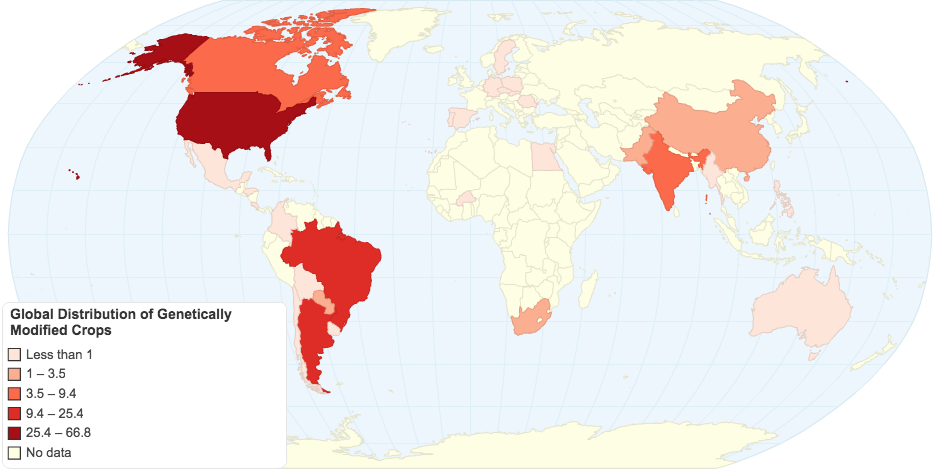This map shows global distribution of Genetically Modified (GM) crops.
- Current World hectarage of biotech crops: 148.6 million hectares in 2010
- World hectarage of biotech crops: 135 million hectares in 2009
Key findings of 2010:
- Growth remains strong, with biotech hectarage increasing 14 million hectares -- or 10 percent -- between 2009 and 2010.
- Farmers in Pakistan and Myanmar, planted insect-resistant Bt cotton for the first time.
- Sweden (the first Scandinavian country to commercialize biotech crops) planted a new biotech high-quality starch potato approved for industrial and feed use.
- Germany also planted the same biotech potatoes as Sweden in 2010, resuming its place among the eight EU nations now growing either biotech maize or potatoes.
- The most popular crop is soya, while the most common modification is tolerance to herbicides.
- International Service for the Acquisition of Agri-biotech Applications (ISAAA) expects an additional 12 countries to adopt biotech crops by 2015.
As recently as a decade ago, Genetically Modified (GM) agriculture was virtually non-existent, but has since expanded rapidly, both in terms of total area planted and the number of countries involved. GM crops is the fastest adopted crop technology, 80-fold increase from 1996 to 2010, year-to-year growth of 9 million hectares or 7%.
What is Genetically Modified (GM) crops?
Genetically modified (GM) crops are crops derived from genetically modified organisms. Genetically modified organisms have had specific changes introduced into their DNA by genetic engineering techniques. These techniques are much more precise than mutagenesis (mutation breeding) where an organism is exposed to radiation or chemicals to create a non-specific but stable change. These plants will have increased resistance to herbicides or improved nutritional content.
For example (Deborah B. Whitman 2000), plant geneticists can isolate a gene responsible for drought tolerance and insert that gene into a different plant. The new genetically-modified plant will gain drought tolerance as well. Not only can genes be transferred from one plant to another, but genes from non-plant organisms also can be used. The best known example of this is the use of B.t. genes in corn and other crops. B.t., or Bacillus thuringiensis, is a naturally occurring bacterium that produces crystal proteins that are lethal to insect larvae. B.t. crystal protein genes have been transferred into corn, enabling the corn to produce its own pesticides against insects such as the European corn borer.
For more information about GM crops please follow the reference link below.
15 years ago

